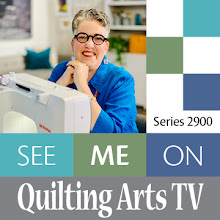 |
Front of the a quilt finished using a non-mitred facing
“Snow Shadows” by Susan Brubaker Knapp
|
I taught two workshops on Wholecloth Painting to members of the Charlotte Quilters’ Guild this week. Each time I teach a class on an art quilt method, I inevitably get questions about my finishing techniques. So I decided to get my act together and do a few more tutorials on the subject.
Over the past few years, I have started finishing most of my art quilts using one of three methods; a non-mitred facing, a mitred facing, or a pillowcase turn. I now have directions for each of these techniques in PDF format available on my blog. (Look in the column on the right-hand side, under the “Free Stuff” heading, then click on the PDF you want to download.) I have tried to provide clear, easy-t0-follow instructions, with lots of photos.
To download a PDF now, click on the links below:
In this post, I’ll show you how to do a non-mitred facing. There are many methods for facing a quilt. This one is a combination of methods I have learned from others, and is the one that is the easiest facing technique for beginners.
Non-mitred facing
1. Quilt your quilt, and then, as you would with a traditional quilt, trim through the top, batting and backing, squaring up the corners, so that the backing and batting are even with the edge of the quilt.
2. Measure the top of your quilt and cut two 2"-wide facing strips this length. Measure the side of your quilt, and cut two 2"-wide facing strips this length minus 2". (For example, if your quilt is 15" wide by 20" long, cut two facing strips 2" x 15" and two facing strips 2" x 18".)
3. On one long edge of each of the four facing strips, turn under ¼" toward the wrong side of the fabric, and press. Pin the unfolded edge of the top strip to the raw edge of the top of the quilt, right sides together:
4. Put the walking foot on your machine. Starting at the top of the short end of the strip, and with a ¼" seam, stitch down to ¼" away from the corner, pivot, stitch the length of the side to ¼" away from the corner, pivot, and stitch up to the top of the other short side. Backstitch at the start and stop.
Clip corners close to stitched line:
5. Stitch the bottom strip on the opposite side of the quilt next, in the same manner:
6. Place one of the side strips along one side of the quilt, with the unfolded edge of the strip next to the raw edge of the quilt, right sides together. Center the strip along the edge, and pin:
This strip should overlap the facing strips you have already sewn on, but should not extend all the way to the corners:
7. Stitch a ¼" seam the length of the strip, back-stitching at the start and end. Your seam should align with the seam for the top and bottom strips:
8. Fold back the two side facing strips and press. From the front side, stitch along the edges about 1/8" from the seam, through the facing and the seam allowance, and back-stitching at the start and end. This seam, often used in garment construction, will help the facing turn more easily to the back:
9. Fold back the top and bottom strips, and use a blunt-tipped tool to push out corners. From the front side, stitch along the edges about 1/8” from the seam, through the facing and the seam allowance. It is impossible to stitch around the corners; simply stitch up as far into the corners as you can.
10. Bring the facing strips around to the back and pin so that the side strips are tucked underneath the top and bottom facing strips, with their raw edges hidden. This usually requires heavy pinning:
The facing strips should not show from the front; a small bit of the front of the quilt should show on the back of the piece:
11. Hand stitch the facing in place along the inner, folded edge of the facing strips on the back. You should only be stitching through the facing strips, backing fabric, and batting. Make sure not to stitch through the front of the quilt.
12. This technique creates a nicely finished piece that looks more like a piece of art than a quilt:
 |
| Back of the finished quilt |
 |
Front of the finished quilt
“Snow Shadows” by Susan Brubaker Knapp |
The PDF with the instructions is free; feel free to print it out and use it, and it share it with others. I just ask that you keep my name, website and blog addresses on the directions when you do so. Thanks!
































































